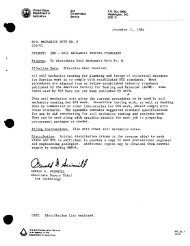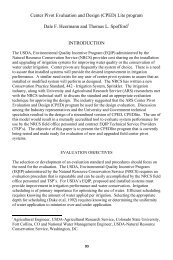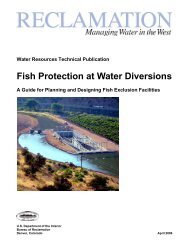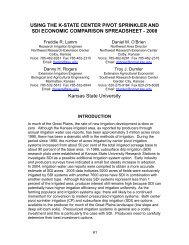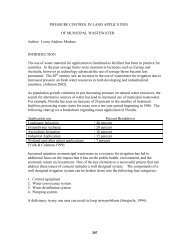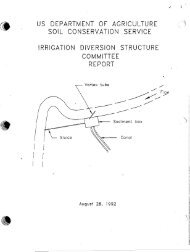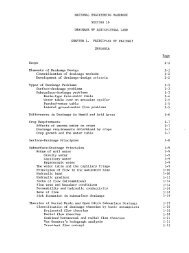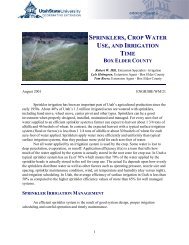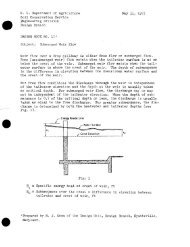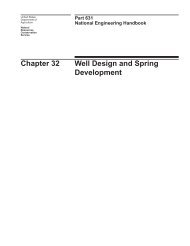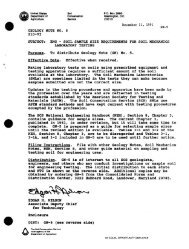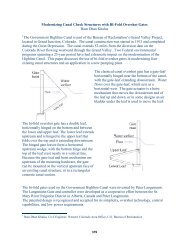Chapter 11: Sprinkle Irrigation - NRCS Irrigation ToolBox Home Page
Chapter 11: Sprinkle Irrigation - NRCS Irrigation ToolBox Home Page
Chapter 11: Sprinkle Irrigation - NRCS Irrigation ToolBox Home Page
Create successful ePaper yourself
Turn your PDF publications into a flip-book with our unique Google optimized e-Paper software.
Side-roll laterals up ta 1,600 ft long are satisfactory<br />
for use on close-planted crops and smooth<br />
topography. For rough or steep topography and for<br />
row crops with deep furrows, such as potatoes,<br />
laterals up to onemfourth mile long are recommended.<br />
Typically, 4- or 5-in-diameter aluminum<br />
tubing is used. For a standard quarter-mile lateral<br />
on a close-spaced crop at least 3 lengths of pipe to<br />
either side of a center power unit should be 0.072-in<br />
heavy walled aluminum tubing. For longer lines and<br />
in deep-furrowed row crops or on steep topography<br />
more heavy walled tubing should be used, enabling<br />
the laterals to roll more smoothly and uniformly<br />
and with less chance of breaking.<br />
A well designed side-roll lateral should have quick<br />
drains at each coupler. All sprinklers should be pro*<br />
vided with a self leveler so that regardless of the<br />
position at which the lateral pipe is stopped each<br />
sprinkler will be upright. In addition the lateral<br />
should be provided with at least two wind braces,<br />
one on either side of the power mover, and with a<br />
flexible or telescoping section to connect the lateral<br />
to the mainline hydrant valves.<br />
Trail tubes or tag lines are sometimes added to<br />
heavy walled 5-in side-roll lines. With sprinklers<br />
mounted along the trail tubes the system has the<br />
capacity to irrigate more land than the conventional<br />
side-roll laterals. Special couplers with a rotating<br />
section are needed so the lateral can be rolled forward.<br />
Quick couplers are also required at the end of<br />
each trail tube so they can be detached when a<br />
lateral reaches its last operating position. The<br />
lateral must be rolled back to the starting location<br />
where the trail tubes are, then reattached far the<br />
beginning of a new irrigation cycle.<br />
Side-Move Lateral<br />
Side-move laterals are moved periodically across<br />
the field in a manner similar to side-roll laterals. An<br />
important difference is that the pipeline is carried<br />
above the wheels on small "A" frames instead of<br />
serving as the axle. Typically, the pipe is carried 5<br />
ft above the ground and the wheel carriages are<br />
spaced 50 ft apart. A trail tube with <strong>11</strong> sprinklers<br />
mounted at 30-ft intervals is pulled behind each<br />
wheel carriage, Thus, the system wets a strip 320 ft<br />
wide, allowing a quarter-mile long line to irrigate<br />
pproximately <strong>11</strong> acres at a setting. This system<br />
roduces high uniformity and low application rates.<br />
Side-move lateral systems are suitable for most<br />
field and vegetable crops, For field corn, however,<br />
the trail tubes cannot be used, and the "A" frames<br />
must be extended to provide a minimum ground<br />
clearance of 7 ft. Small (60 to 100 gpm) gun sprinklers<br />
mounted at every other carriage will irrigate a<br />
150-ft-wide strip, and a quarter-mile-long lateral can<br />
irrigate 4.5 acres per setting. Application rates,<br />
however, are relatively high (approximately 0.5 iph),<br />
The job of moving a hand-move system requires<br />
more than twice the amount of time per irrigated<br />
acre and is not nearly as easy as the job of moving<br />
an end-tow, side-roll, or side-move system, A major<br />
inconvenience of these mechanical move systems occurs,<br />
however, when the laterals reach the end of an<br />
irrigation cycle. When this happens with a handmove<br />
system, the laterals at the field boundaries<br />
can be disassembled, loaded on a trailer, and hauled<br />
to the starting position at the opposite boundary.<br />
Unfortunately, the mechanical move laterals cannot<br />
be readily disassembled; therefore, each one must<br />
be deadheaded back to its starting position. This<br />
operation is quite time consuming, especially where<br />
trail tubes are involved.<br />
Fixed <strong>Sprinkle</strong>r<br />
A fixed-sprinkler system has enough lateral pipe<br />
and sprinkler heads so that none of the laterals<br />
need to be moved for irrigation purposes after being<br />
placed in the field. Thus to irrigate the field the<br />
sprinklers only need to be cycled on and off, The<br />
three main types of fixed systems are those with<br />
solid-set portable hand-move laterals (fig. <strong>11</strong>-4),<br />
buried or permanent laterals, and sequencing valve<br />
laterals. Most fixed sprinkler systems have small<br />
sprinklers spaced 30 to 80 ft apart, but some systems<br />
use small gun sprinklers spaced 100 to 160 ft<br />
apart.<br />
Solid-Set Portable<br />
Solid-set portable systems are used for potatoes<br />
and other high-value crops where the system can be<br />
moved from field to field as the crop rotation or<br />
irrigation plan for the farm is changed. These systems<br />
are also maved from field to field to germinate<br />
such crops as lettuce, which are then furrow irrigated.<br />
Moving the laterals into and out of the field<br />
requires much labor, although this requirement can<br />
be reduced by the use of special trailers on which<br />
the portable lateral pipe can be stacked by hand.<br />
After a trailer has been properly loaded, the pipe is<br />
banded in several places to form a bundle that is<br />
lifted off the trailer at the farm storage yard with a



